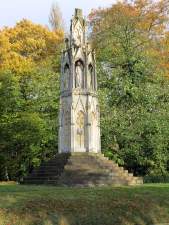
A 20 minute walk, somewhat bleak, out of the centre of Northampton, southwards along first Bridge Street, over the river, carrying on along the road, now called Cotton End and then becoming London Road (the A508) takes the visitor to the Hardingstone Eleanor Cross, a medieval relict with fine sculpture from the 13th Century. A note on Eleanor Crosses is on this page; suffice it to mention here that after Queen Eleanor’s death in 1890, her grief stricken husband, King Edward I, ordered a cross to be set up on each resting stage of her funeral cortege as it travelled from Lincolnshire back to London; one of the three surviving crosses is this one.
It stands now by the side of the busy road, yet the trees behind and around the little open space give it a fine aspect, as shown above. It is raised up today on an octagonal series of steps, and is in three sections. The lowest of these, somewhat over twice the height of a tall man, has blank Gothic arches on each of its eight sides, each with divided into two with a vertical element or mullion, splitting at the top of the arch, and each with a pair of shields of arms - Leon and Castile, England and Ponthieu are represented. Alternate arches also include sculpted open books at middle height. This section is surmounted by a decorative upper border or battlement. Above this rises the second storey, again octagonal, with pillared arches forming canopies around a solid centre; the positioning of the arches being such that the whole of this second level is but little reduced in diameter from that beneath it, but considerably lighter. Within each of the four canopies stands a statue in the same stone of Queen Eleanor, a little over life size, and in various states of repair. The canopies rise above in a Gothic profusion of points and spires, topped with decorative terminals. The overall height of this second stage is a couple of feet less than that beneath, thus about 12 ft. The third stage, much reduced in breadth, and about 8ft high, is square in cross section, and bears similar blind windows to the first stage, but with three mullions and more of the appearance of the tracery of a stained glass window; little pinnacles rise at the corners. Above all this, within a crown, rises the shorn-off shaft of the cross for a couple of ft further. We should add that above the various arches on different levels are minor tracery and leaf carvings, with the upper border to the first stage being embellished with drooping-leaved flowers.
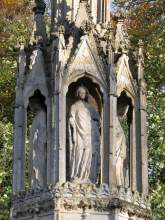 Third tier of the Hardingstone Cross with sculpture.
Third tier of the Hardingstone Cross with sculpture.
As we would expect, the edifice has been mauled and repaired over the ages, most notably a much criticised restoration of 1713, which included a sundial and a new cross, and a marble plaque to record the changes. In 1840 this new cross was still in place; by the 1870s it was gone. The stonework is much worn, and in parts replaced, and we have to question whether the road could not have been a few feet further away from the monument to avoid risk of acid pollution damaging the stone further in recent times.


 Eleanor statues, by William of Ireland.
Eleanor statues, by William of Ireland.
Now to the four statues, figural sculpture being the main interest of these pages. The sculptor is known – he is William of Ireland, mason-carver, and the date of the statues is 1292. There are strong similarities between the figures, which are all standing, crowned, the head with long wavy hair, and the body with long, graceful drapes down to the ground, and rather enveloping the body to conceal rather than emphasise the form, yet with enough clinginess to give a clearly delineated pose rather than a drape with a head on it as on so many funereal effigies.
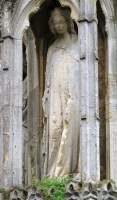
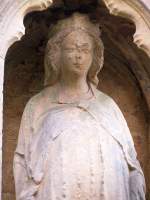 Eleanor figure with the most complete face, and bow to neck.
Eleanor figure with the most complete face, and bow to neck.
The drapes, indeed, vary between the figures, and are rendered with confidence and a sure touch. The most damage of time has been to the lower arms and hands, mostly gone, though the one seems to hold some pot, and some are deemed or surmised to have held at one time orbs and sceptres. The faces, too, have been damaged, and in one case at least look repaired. One at least, above, feels as it should be, with medieval face small pursed lips, rounded cheeks above a plump chin, and above all the lightly delineated eyes, partly closed, below arched brows and a smooth forehead. The pose appears bland, but viewed from an angle, we see a graceful forward tilt to the neck which adds character and naturalness. The faces of the other figures are more damaged; in one the eyes and nose are still good, but the damage to the chin leaves the remaining part of the mouth with an unfortunate twist; the pose of this figure, though, is excellent, with a relaxed s-shape from neck, through upper body to hips and down the curve of the non-weight-bearing leg. Perhaps it is this disturbing decay to the face which makes the most satisfying figure that which has no features to the face at all; it is as if the face has been indicated in a sketch to give proportion, framed by a crown equally lightly sketched, and wavy hair, and we are left to focus on the posture and the folds of the drapery. We see hanging folds over and around the arms, bold concentric curves across the lower torso, and light, almost frilly wisps on the lower leg. These statues want studying from different vantages and in different lights to appreciate them to the full.
The other Eleanor Crosses are noted, as we have said, on this page. But we should include here at least a picture of the Victorian rendering of Eleanor, in Northampton on the front of the Guildhall. A rather more solid figure, well enough done, and though at a height and foreshortened, we can appreciate that the hands at least retain a delicacy despite the erosion of the soft stone. The figure is not particularly inspired by the Hardingstone Queen’s Cross figures in pose or drapery, yet we can see how the hands might once have been placed on some of the medieval figures, one on a sceptre, one on the upper chest. Although there is something of a canopy, and the Guildhall is in a relatively narrow street, this and the companion 19th Century figures are much more exposed, and seem likely to be far outlasted by their fair cousins on the Eleanor Cross.
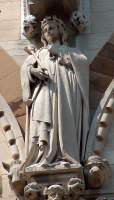 Northampton Guildhall Eleanor, by R. Boulton.
Northampton Guildhall Eleanor, by R. Boulton.
We end with a rather eerie picture, as by chance when I was photographing the monument, a band of rain behind gave for some few seconds the end of a rainbow which seemed from my viewpoint almost to emerge from the pinnacle of the ruined cross.
This page was originally part of a 'sculpture of the month' series, for Dec. 2014. Although the older pages in that series have been absorbed within the site, if you would wish to follow the original monthly series, then jump to this page (Jan. 2013) or the previous month (Nov. 2012). To continue, go to the bottom of each page where a paragraph like this one allows you to continue to follow the monthly links.
Eleanor Crosses // Waltham Cross // Northampton
Sculptors // Sculpture in some English towns
Visits to this page from 1 Dec 2012: 7,634